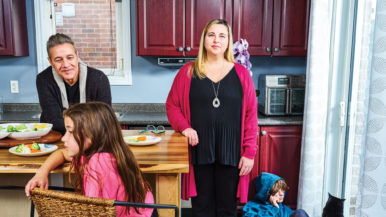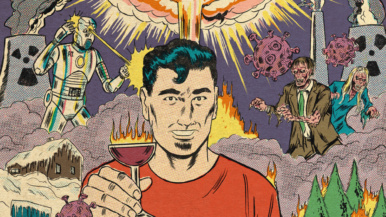Answers at last: why the King streetcar is so awful

The King streetcar is the busiest of the TTC’s surface routes. Every weekday, some 60,000 passengers use the line, making it more crowded than the Scarborough RT and Sheppard subway combined. Despite transit riders drastically outnumbering motorists—approximately 20,000 private vehicles use the street on a typical weekday—the route during rush hour is a dispiriting, slow-moving, overcrowded mess.
So what’s the holdup? A newly released city staff report, commissioned in October to examine the feasibility of separated transit lanes on King, has some interesting answers.
The single biggest cause of rush-hour “delay” (defined as the streetcar moving at under walking speed) is “passenger service time”: the loading or unloading of people. Put simply, half of all stoppages are caused by people entering or exiting.
It might seem absurd to lump boarding and alighting times in with traffic and other delays, because handling passengers is, after all, the streetcar line’s entire reason for being. But just because stopping for riders is a necessity doesn’t mean the process is ideal. On King, riders must board through the front door, pay the fare or present a pass and sometimes collect a transfer. They have to do this one at a time, slowly.
The new streetcars, which are currently scheduled to appear on King in 2017, are expected to speed up the boarding process by accepting electronic Presto payments and allowing passengers to enter through any of the four doors.
The second leading cause of rush-hour delay, the study says, is traffic lights. Although many of King Street’s controlled intersections are fitted with special equipment for prioritizing public transit, about 30 percent of stoppages were caused by red lights. Several intersections without transit-friendly technology are among the busiest: Spadina, University, Bay, and Yonge. Giving priority to streetcars at these lights would lead to delays on the intersecting streets, the report said.
Surprisingly, traffic congestion seems to result in fewer delays. The report says the worst congestion delays occur heading west during the afternoon rush, when almost three minutes of the average end-to-end trip (Broadview to Dundas West station) are spent stationary or barely moving due to the sheer number of cars, taxis or illegally parked delivery vehicles on the street.
So, are separated lanes for streetcars the answer? The report is staying mum, for now. The study found that streetcars reach the highest speeds between Jarvis and Berkeley streets, where the track is reserved for public transit during rush hour, but similar lanes between Dufferin and John appear not to have the same effect. The 1.5-kilometre downtown stretch between John and Jarvis, where there are no reserved lanes, moved the slowest, topping out at around 10 kilometres per hour.
City staff will study other measures for improving service, including tweaking signal priorities, extending rush-hour reserved lanes and stricter law enforcement. A follow-up report is due in 2015.






Notwithstanding the fact that the Report is written like a High School project before the internet existed and just states the most obvious results with appendices that are not very helpful, why does it take 2 and a half years for the delivery of new street cars?
Because it is a massive order that was only made four years ago. The first few have been delivered, after months of rigorous testing, and will begin appearing on the 510 Spadina later this month.
Put a damn subway under king St. for God’s sake!
The reason it takes so long to get on is also because there are way too many people on most of the streetcars – meaning people have to slowly shuffle back and fill space (and sidestep strollers and large items) to make room for people at the front. When that doesn’t work, people simply go to the back doors and try to push their way in, which causes a lot of the delays that I see personally.
One problem is the single-occupant (or the average of 1.3 people) motor vehicles driving on the streetcar tracks. If they had used either cobblestones or rubble strips in the concrete, maybe that would induce those vehicles off the tracks.
The streetcars should have camcorders, which could record GPS locations, timestamps, and vehicle license plates, for later computer generated traffic infractions to be mailed out. Else have a cop on board to step out and issue tickets.
Another problem are with the passengers who continue to exit through the front doors, delaying the passengers who want to enter the streetcars (and buses, for that matter).
Yes but some of the drivers don’t open the back doors and force everyone to board at the front, which slows things down, especially when there are 50 or more people trying to get on because the last street car came by 15 minutes ago and was already full (at rush hour). At Yonge and University, they should just open all doors and let people board as fast as possible.
Everything about the TTC is awful. A lot of it isn’t their fault, but it’s still awful.
Just announced by the TTC that by January 1, 2015, ALL streetcars will be POP. About time that the TTC got into the 20th century. They’ll get into the 21st century when they implement time-based transfers.
We could just do the DRL and have it arrive on King instead of Union.
The back door entry is a double-edged sword. I regularly get on the Spadina car northbound from King, and until it went out for construction all-door boarding makes it near-impossible to get out the back doors at any but the most popular stops north of Dundas. The car is so packed that there are several people stuffed into the exit way, balanced on the edge or the upper steps. Hoping the new cars will alleviate this mess.
Part of that is that some people don’t have the common courtesy to move out of the way to let people on or off. Or some people in a hurry to just get on rush the doors and block other passengers trying to disembark. Some politeness could go a long way.
Have a cop on every streetcar? Who’s going to pay for that?
how’s intensification working for you. Nice if you live in Rosedale not so nice when you have to be the rat in the experiment
How about King & Queen one-way like Richmond & Adelaide
So why not put contactless on the exiting cars? I can supply a solution that works well and doesn’t cost a fortune. As the first Mifare card user in Australia for passenger fares, I know a thing or two about the system and can get the street cars fitting quickly. The system I use can handle three passengers a second, you just have to let them move that fast.